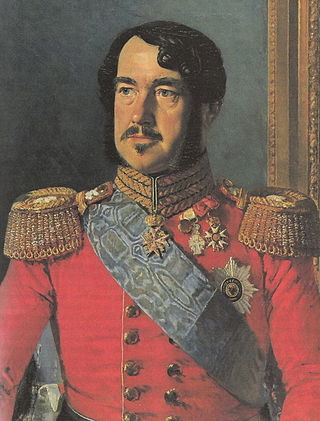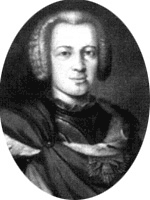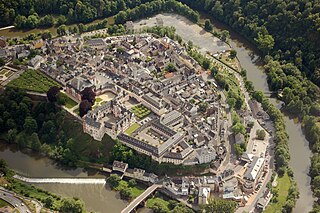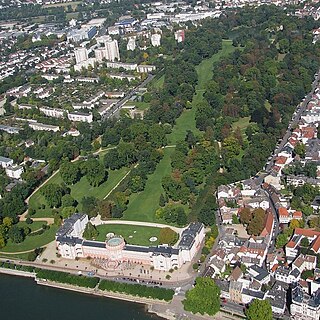
Wiesbaden is a city in central western Germany and the capital of the state of Hesse. As of June 2020, it had 290,955 inhabitants, plus approximately 21,000 United States citizens. The Wiesbaden urban area is home to approximately 560,000 people. Wiesbaden is the second-largest city in Hesse after Frankfurt am Main.

Biebrich is a borough of the city of Wiesbaden, Hesse, Germany. With over 38,000 inhabitants, it is the most-populated of Wiesbaden's boroughs. It is located south of the city center on the Rhine River, opposite the Mainz borough of Mombach. Biebrich was an independent city until it was incorporated into Wiesbaden in 1926.

Idstein is a town of about 25,000 inhabitants in the Rheingau-Taunus-Kreis in the Regierungsbezirk of Darmstadt in Hesse, Germany. Because of its well preserved historical Altstadt it is part of the Deutsche Fachwerkstraße, connecting towns with fine fachwerk buildings and houses. In 2002, the town hosted the 42nd Hessentag state festival.

Usingen is a small town in the Hochtaunuskreis in Hessen, Germany. Until 1972, this residential and school town was the seat of the former district of Usingen.

Prince William of Hesse-Kassel was the first son of Prince Frederick of Hesse-Kassel and Princess Caroline of Nassau-Usingen. He was titular Landgrave of Hesse-Kassel-(Rumpenheim) and for many years heir presumptive to the throne of Hesse-Kassel.

Prince Frederick of Hesse-Kassel was a younger member of the dynasty that ruled the Landgraviate of Hesse-Kassel and a Danish general.

Johann Ernst of Nassau-Weilburg was an Imperial Generalfeldmarschall, from 1675 to 1688 Count and from 1688 until his death Prince (Fürst) of Nassau-Weiburg.

Princess Caroline of Nassau-Usingen was the elder daughter of Karl Wilhelm, Prince of Nassau-Usingen, and wife of Landgrave Frederick of Hesse-Kassel.

Friedrich August, Duke of Nassau, Prince of Nassau-Usingen was the last Prince of Nassau-Usingen and, jointly with his cousin, Friedrich Wilhelm of Nassau-Weilburg, first Duke of Nassau. He died without surviving male issue and was succeeded by his cousin's son, Wilhelm.

Walrad Usingen of Nassau, was from 1659 Count, and from 1688 Prince of Nassau-Usingen and founder of Usingen line of the House of Nassau. He served for most of his career as a general in the Dutch States Army.

George August Samuel of Nassau-Idstein was Graf from 1677, and Prince from 1688 until his death, of Nassau-Idstein. He worked mainly in Wiesbaden.

Charles, Prince of Nassau-Usingen, was Prince of Nassau-Usingen from 1718 to 1775.

Saarbrücken Castle is a Baroque château in Saarbrücken, the capital of Saarland. It is located in the district of Alt-Saarbrücken on the left bank of the Saar. Earlier, a medieval castle and a Renaissance castle stood on the same site.

Wiesbaden City Palace is a neo-classical building in the center of Wiesbaden, Germany. It was completed in 1841 as the principal city residence of the Dukes of Nassau. The palace has several wings, 145 rooms, and is architecturally integrated with a group of ancillary buildings constructed both before and after it was built. With ornate towers, gables and a slate roof laid in herringbone patterns, the three-story complex lends charm and its name to the central square of Wiesbaden: Palace Square.

Idstein Castle, later the Renaissance style Schloss Idstein, is located in Idstein in the county of Rheingau-Taunus, Germany. The hill castle was the residenz of the counts of Nassau-Idstein. The castle's Witches' Tower (Hexenturm) is one of the town's oldest buildings and a substantial local landmark.
Karl Philipp of Weilnau, was the first Count of Weilnau, and a Captain in the Holy Roman Imperial Army.

Schloss Kirchheimbolanden is located in the town of Kirchheimbolanden in the German state of Rhineland-Palatinate. As a castle the site was first mentioned in a document as early as 1390.

Schloss Weilburg is a Baroque schloss in Weilburg, Hesse, Germany. It is located on a spur above the river Lahn and occupies about half of the area of the Old Town of Weilburg. It contains the Hochschloss, built between 1530 and 1572, which is one of the best-preserved Renaissance palaces in Hesse. In the 1700s, the palace was expanded by John Ernst, Count of Nassau-Weilburg, and his builder, Julius Ludwig Rothweil. The buildings and gardens now belong to the Verwaltung der Staatlichen Schlösser und Gärten Hessen, and they can be visited as a museum on guided tours. Parts of the palace are venues for the music festival Weilburger Schlosskonzerte, which is named after the palace.

The Schlosspark Biebrich is a park at Schloss Biebrich in Wiesbaden-Biebrich, Hesse, Germany. First designed as a French formal garden, it was expanded changed to an English landscape garden and expanded 1817 to 1823, the last project of Friedrich Ludwig von Sckell. The public park extends north of the building in the valley of the Mosbach creek for around 1,200 m and is 250 m wide. It is the venue for the annual horse show Internationales Pfingstturnier Wiesbaden.

Friedrich Joachim Michael Stengel was a German architect and baumeister.





















